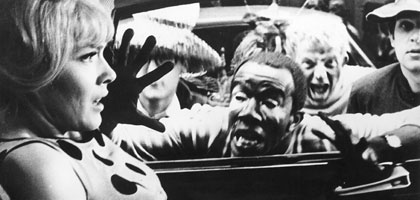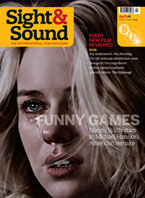Mother of invention
DVD review: 4 by Agnès Varda

Tim Lucas on Agnès Varda, whose documentarian style constantly defies the trends and precepts of French cinema
4 by Agnès Varda
La Pointe courte/Cleo from 5 to 7/Le Bonheur/Vagabond
Agnès Varda, France 1954-85; Criterion/Region 1; Aspect Ratio 1.33: 1; Features: cast reunion documentaries, short films, television and radio interviews, trailers, 60-page illustrated essay booklet
Agnès Varda's Cleo from 5 to 7 (1961), a lustrous fiction in a documentary setting told in real time, was first released by Criterion, without supplements, eight years ago. Now a new and appreciably deeper 1.66:1 high-definition transfer, generously accented with extras, has been reissued as part of this marvellously diverting crash course in the major arcana cards of the 'grandmother of the nouvelle vague' - so called because her independent feature La Pointe courte, introducing Philippe Noiret, was made in 1954 for a tenth of the usual French feature budget. But Varda's work stands resolutely outside the trends and precepts of her national cinema, her films unfolding from the perspective of an earth-mother rather than a grand-mère. The first thing one notices about her films, dipping into La Pointe courte, remains a consistent quality throughout the total selection: Varda is more interested in community than in the individual, interested in drama only to the extent that it provides stimulus for her documentarian mill.
La Pointe courte, set in a Mediterranean fishing village being squeezed out of existence by new laws against shellfishing, contrasts the reality of its background setting, filmed with authentic locals, with the artifice of its foreground story: the tentative reunion of a married couple (Noiret, Silvia Monfort) after a five-day separation. It's open to question whether this debut bears any direct relation to the nouvelle vague, but its poised, sculptural framing of the couple's existential dialogue certainly blazed a trail for Ingmar Bergman to follow in the 1960s. Even when the actors take centre screen, Varda's camera delights in unmooring itself from their tether and drifting omnisciently through broken windows and open-ended wicker baskets. Varda has always insisted that she made this film before becoming film-literate, citing Citizen Kane as one of the few features she'd seen at the time; whether or not one accepts this, her tyro effort (edited by Alain Resnais) remains stylistically fresh and innovative after more than half a century.
The jump from La Pointe courte to Cleo from 5 to 7 is exciting, as Varda attends the slow meltdown of a spoiled yé-yé pop singer (Corinne Marchand), as allergic to life as she is fearful of death, as she walks the streets of Paris while awaiting the results of a biopsy test. Meticulously (because artificially) filmed in real time, Cleo's wanderings lead her into the company of a soldier on leave (Antoine Bourseiller) and the serendipity of this meeting is one of the sweetest surprises in 1960s French cinema. There is also an unmistakable nod to the nouvelle vague in the form of a movie-within-the-movie, a charming faux silent comedy featuring Jean-Luc Godard, Anna Karina and Eddie Constantine, in which Godard - evidently a natural heir to Buster Keaton - learns to do away with his trademark shades in the name of true love. This disc also features Varda's adventurously abstract short L'Opéra Mouffe (1958), scored by Georges Delerue, which contrasts the haggard, rumpled elder denizens of the rue Mouffetard area of the Left Bank district with a pair of young lovers (including Cleo cast member Dorothée Blank, possibly the first actress to do full-frontal nudity in a 'respectable' film) and images of fertility, among them studies of the nude pregnant body of the film-maker herself.
The third film in the set, Le Bonheur (1965) is unexpectedly profound, lingering and gnawing. Jean-Claude Drouot stars, with his non-professional wife Claire and their two children, as a blissfully contented married man who finds himself drawn - without the guilt complications that are usually the cinema's only reason to tell such a story - to an attractive and responsive postal worker (Marie-France Boyer). After viewing only a few minutes of the Drouot family's beatific picnicking in Fontenay-aux-Roses settings that might have been painted by Renoir or Monet, the viewer can't resist imagining what sort of demonic obstacle Buñuel might have concocted for them to trip over; indeed, this guileless film proves to be more about our inability to accept or trust in happiness than about its own seeming naivety. The austere manner in which Varda filmed its lovemaking scenes would appear to have influenced those of Claude Lelouch's A Man and a Woman (released the following year) and the peculiar handling of a drowning scene anticipates Nicolas Roeg's Don't Look Now.
For this writer, Vagabond (1985) - Varda's greatest success, winning the Venice Festival's Golden Lion and a best actress César for 17-year-old Sandrine Bonnaire - is the least prepossessing of the cards in this attractive deck. Inspired by images from the life and fiction of Russian-born French novelist Nathalie Sarraute (featured in a 1986 radio interview), it takes a Citizen Kane approach into Truffaut territory, beginning with the discovery of a dead teenage wild child in a ditch and depicting how she got there through touching interviews with a mostly non-professional cast (Une femme mariée's Macha Méril a notable exception). The extras propose Bonnaire's character as a rebel, as heroic, but there is nothing in her portrayal to suggest anything nobler than stubborn sociopathy in her covert nature. Bonnaire has a wonderful scene though, with octogenarian Marthe Jarnias - the subject of her own short featurette, and just about the last woman I ever expected to see naked.


